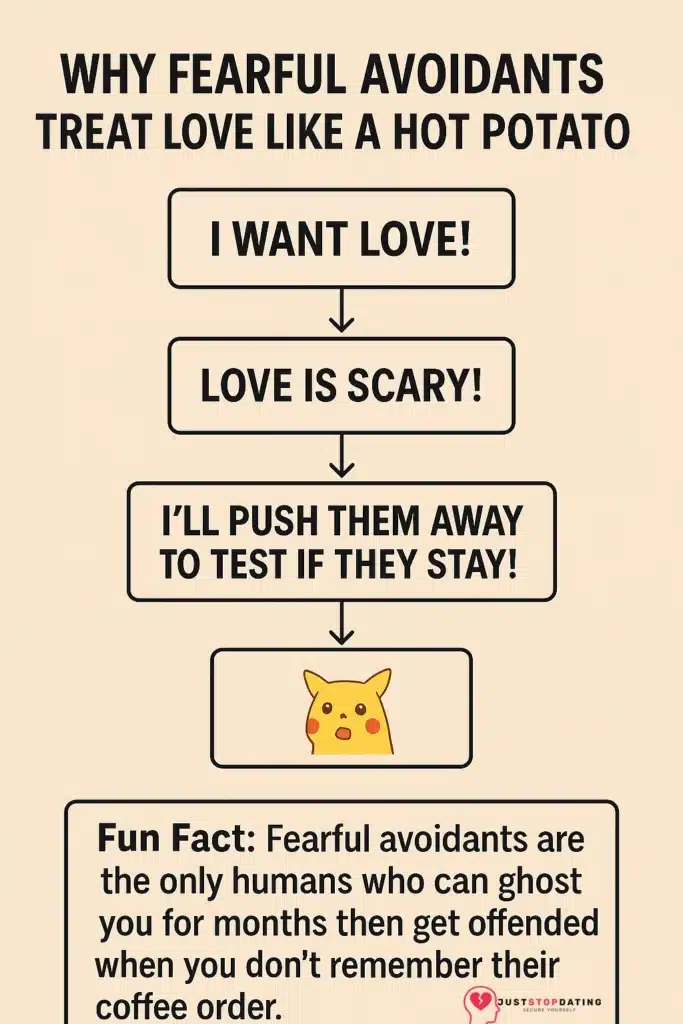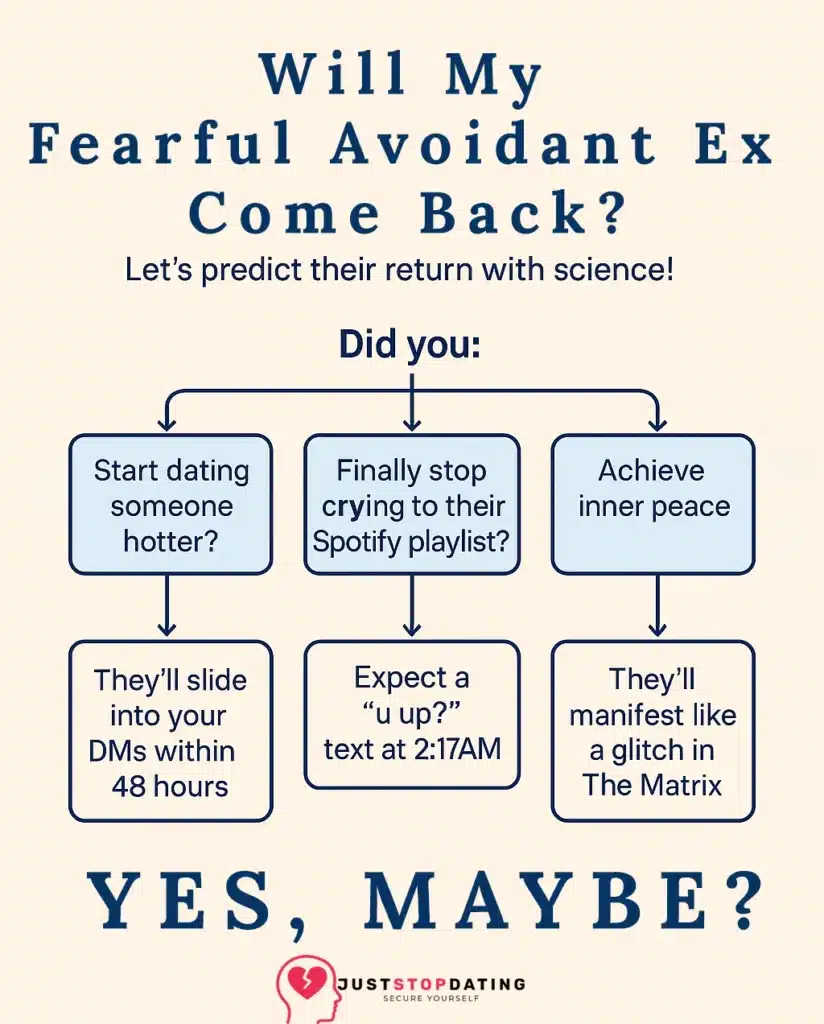I am your fearful avoidant ex. The one who breaks up with you because, “it’s not you, it’s me” (Dude, it was always me.). What I struggled to realize is that I am constantly running from intimacy that I desperately want. I love connecting with people. But I noticed, I have this strange habit of giving only a little bit of myself and hiding the rest because I am afraid of not being a good enough for myself or anyone else. That’s the major difference between a fearful avoidant ex (FA) and a dismissive avoidant (DA).
- FA = rock bottom self-esteem of an anxiously attached person and the avoidance tendencies of a DA (Lee & Hankin, 2009)
- DA = emotional detachment and IDGAF attitude (Sagone et al, 2023)
I still crave connection but I panic the moment things get “too hard”. I recently learned about maladaptive avoidance-based coping mechanisms and what triggers these responses but I didn’t realize that these mechanisms arise when I was busy convincing myself that I needed space in the relationship, I miss my freedom, or the worse one that was so cruel, “I can’t even think when I’m around you!”
I am going to explain to you what’s happening in the mind of a fearful avoidant ex and why we approach relationships as emotionally unavailable with a sprinkle of extra drama.
Why a Fearful Avoidant Ex Treats Love Like a Hot Potato
Your fearful avoidant ex is basically a romance-themed escape room designed by a trauma-informed dungeon master. No two fearful aoidants are exactly the same. We’re more like distant cousins, than siblings. One minute, we are slipping you the key to our heart like it’s an act of divine trust. Next minute, we’ve sealed ourselves behind a velvet rope and blocked you on all platforms except Venmo/CashApp/Zelle. But here’s the thing: these mixed signals aren’t about you.
Fearful-avoidants get stuck in self-perpetuating cycles that are rooted in attachment dysregulation, which are a pattern of unstable emotional responses in close relationships that are caused by inconsistent early attachments. In an attempt to protect themselves, people who are fearful avoidant struggle to balance their need for closeness with their fear of rejection, abandonment, or engulfment.
This fear is triggered when a fearful avoidant feels emotionally close to someone: they pull away, shut down, or test your commitment to the relationship, even though they want your love. This becomes a cycle of approach and avoidance that reinforces itself every time connection feels threatening. Think of it like this (Figure 1): “I want love!”, followed by “Love is scary!”, then “I’ll push them away to test if they stay!” (self-sabotage), and finally, the emotional climax: surprised Pikachu face because you actually walked away from the relationship like a person with self-respect…BRAVO!

The “Idealization-to-Oh-Teenjus-Help!” Pipeline
Your fearful avoidant ex likely began the relationship with intense idealization, making you feel chosen, special, and deeply seen. This early stage, often referred to as love bombing, can feel intoxicating but is rooted in an anxious attempt to secure connection before vulnerability sets in. The shift happens when real intimacy and emotional consistency are required. At this point, the fearful avoidant’s internal alarm system activates. Their thinking moves from, “This person is everything I’ve wanted” to “What if I can’t live up to this new label on the relationship?” or “What if I get hurt?” or “Do I even like this person?” What happens next is emotional withdrawal, distancing, or self-sabotage. When this cycle, pipeline starts up, it has nothing to do with you. It is because fearful avoidants panic when relationships are taken to a level they are not sure they’re ready to maintain.
Ok, So When Will My Fearful Avoidant Ex Come Back?
The fearful avoidant ex tends to follow a predictable emotional rhythm: they feel the warmth of closeness, then immediately panic as unresolved fears of abandonment or engulfment resurface. From there, they begin constructing narratives about how you’ll eventually hurt or reject them, often without evidence. To protect themselves from imagined pain, they reject you first implementing a defensive move framed as clarity (“I have to leave, I can’t be myself around you.“). But after creating distance, they start to miss you. You were the deep connection that they pushed away. Let me show you how the cycle resets itself:

Will You Accept Your Fearful Avoidant Ex or Move On?
Your fearful avoidant ex did not stop caring. We never stop caring about what you think or how you’re feeling Now, that the relationship is over there are a few things that a fearful avoidant will start to realize: (1) They struggled to stay present in the relationship and focused on everything that could possibly go wrong; (2) They sabotaged the relationship and decided it was best that they pull the plug before you could do it; (3) They need to find self-awareness and a professional to guide them or their relationships will crumble.
The question for you, as the person dealing with the drama of the break up might shift from: “Is my fearful avoidant ex coming back?” to, “Do I want this person in my life if they are not ready to be there?” Today and everyday, you decide what kind of love you’re building your life around.
FAQs
How long does it take for a fearful avoidant ex to come back?
There’s no fixed timeline. A fearful avoidant ex may reappear anywhere from a few days to several months after a breakup, often triggered by your silence, visible detachment, or signs that you’ve moved on. When a fearful avoidant comes back, it isn’t always based on emotional clarity. As a fearful-avoidant, we develop a fear of losing connection with you permanently. It’s important to set boundaries that regulate emotional access to you and protect you.
What happens when you stop chasing a fearful avoidant?
When you stop chasing, the fearful avoidant’s nervous system shifts. Without your pursuit, they lose the security of knowing you’re “available,” which can trigger their underlying fear of abandonment. This psychological dissonance often causes them to re-engage but not always in a stable or consistent way. It’s common to see intermittent attempts to reconnect with you that will test your emotional availability. It’s important to develop the discernment to know the difference between real attempts at commitment and the start of another cycle of anxious-avoidant tendencies.
Can you get a fearful avoidant ex back?
Yes, but reconciliation with a fearful avoidant ex typically follows a push-pull pattern unless both people actively address their attachment dynamics. You may rekindle the relationship, but unless they’ve done real emotional work when it comes to conflict, vulnerability, and intimacy, they are likely to end up repeating the same destabilizing cycle.
How to know if a fearful avoidant loves you?
A fearful avoidant may love deeply, but their love often shows up in indirect, contradictory ways. Signs include intense early idealization, subtle check-ins after distance, emotional depth followed by sudden withdrawal, and discomfort during moments of sustained closeness. They may not express love with consistency, but their fear-driven behavior can mask strong underlying attachment. The key is whether they’re working toward safe connection or simply recreating familiar emotional chaos.











